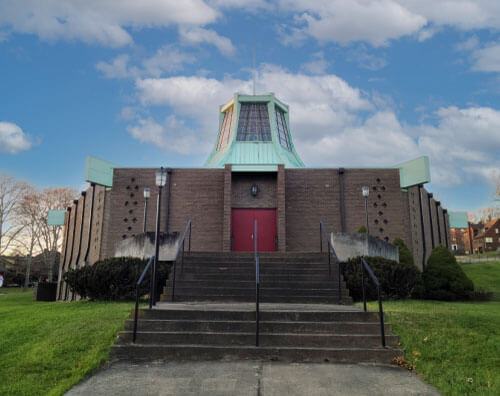First Chrisitan Church

First Christian Church (Disciples of Christ) was founded on May 15, 1831. The church was a direct outgrowth of the Christian Association of Washington, whose leader, Thomas Campbell, wrote the Declaration and Address, one of the founding documents in the Stone-Campbell movement that became the Christian Church (Disciples of Christ). This document declared that “the Church of Christ on earth is essentially, intentionally, and constitutionally one.” It was signed by Thomas Campbell and Thomas Acheson and printed in the Washington Reporter in 1809. A Pennsylvania state historical marker commemorates this act on South Main Street, in front of the Observer-Reporter office in Washington.
Tucker and McAlister wrote, “Of all these religious bodies, one of the largest to have originated on American soil is the Christian Church (Disciples of Christ).” Two of the prominent leaders of this movement, Thomas, and Alexander Campbell, lived in Washington from 1807 to 1812 in a house at the corner of Strawberry Alley and South College Street. Alexander Campbell’s wedding reception took place here in 1811. The Campbells were educated at the University of Glasgow and emigrated to Washington from Armagh in Northern Ireland. Alexander Campbell was a great preacher and religious reformer and founded nearby Bethany College. In 1850, Alexander was awarded an honorary doctorate by Washington and Jefferson College (Jefferson College).
Our Future
The First Christian Church has a rich and proud history. But the focus of our ministry is on the present, with God leading us into an active and vibrant future. We are open to all who seek to join us on the path of Christian discipleship, no matter where you may be joining this trek.
We confront the challenge of living in today’s world in new and creative ways. We worship God in contemporary and traditional ways. We worship God by serving in Washington and throughout the world. We are the community of the First Christian Church.
Our Past
In 1831, two members who had worshipped with the Baptist Church withdrew and joined with others to form a new disciples church. This included Hannah Acheson, sister of Thomas Acheson. They met for five years in a log schoolhouse on the farm of Henry Van Kirk, four miles south of Washington.
In 1836, the first church building was built in Laboratory (Pancake). This was near the Martin Tavern (now the Nichol Funeral Home) on the National Road, where Alexander Campbell stayed when he preached at the church. This one-room brick building still stands and has been converted into a residence. The office of minister rotated in the initial period. Elder Lyman Streator was one of the first ministers, and a Trustee of Bethany College. He is buried in the Washington Cemetery. Robert Milligan, professor at Washington College and T.C. McKeever, a prominent abolitionist, were ministers.
One of the most prominent leaders in the pre-Civil War period was Robert Milligan. Milligan taught English literature, math, and chemistry at Washington College from 1840-52. He later taught at Bethany, and was editor of the Millennial Harbinger. He was the first President of the University of Kentucky and founder of the College of the Bible. Milligan College in Tennessee is named for him.
Another early minister was T.C. McKeever, whose family members were ardent abolitionists. His mother was head of the Pleasant Hill Female Seminary in West Middletown. He was a nephew of Alexander Campbell.
In 1867, the church moved into the City of Washington when it leased and then bought the Cumberland Presbyterian Church on West Wheeling Street. The church was located in the area of the current fire department headquarters. F.D. Power, 1870-71, became minister of the Vermont Avenue Christian Church, Washington, D.C. and was Chaplain of the House of Representatives and later Chaplain of the Senate. He preached the funeral oration in the Capitol Rotunda after the assassination of President James A. Garfield, one of his parishioners.
In 1894, the church had grown and a new building was built across the street on West Wheeling Street. This church served the congregation’s needs well for eight decades. The church had notable pastors including J. M. Kersey, 1896-98, who became President of Bethany College. John W. Love was minister from 1921-1953 and was a prominent leader in the community, officiating at many weddings and funerals. The congregation was considered one of the largest in the community at this time. Peter Macko, 1954-63 helped create the Christian Church in Pennsylvania. In 1964, Robert Pebley was hired with a mandate to build a new church building as the congregation had outgrown the old building. He served until 1986. The old church structure now houses the City Mission.
In 1968, the present structure, the round church, was built, fulfilling long-held dreams. The architect was Fred Loeffler, with the hexagonal sanctuary inspired by Alexander Campbell’s study with light coming in from above. The original design had the communion table in the center and the pulpit to the side. An arson fire destroyed the sanctuary in 1997 and the sanctuary was rebuilt and reopened in 2000 with the current traditional seating arrangement. John Ledford was minister 1987-1997 followed by Paul P. Leone, 2000-2006. Steve Smythers was minister from 2010-2020.
The church closed during COVID in 2021. The church reopened on January 22, 2023, with Rev. Dr. Arthur Keys as minister. Since that time, the congregation has been continually active with an outstanding music program led by Diane Lindley. The church has sponsored a Mardi Gras jazz concert, the Living Last Supper, a Tamburitza Service, and a community Farmers Market. A new Youth Group is active and growing.
